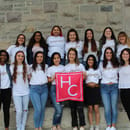Approximately 700,000 Americans today are living with Crohn’s Disease, according to crohnsandcolitis.com. Doctors are struggling to understand the nature of this disease, so many doctors and individuals are still in the dark about.
Crohn’s Disease, in simple terms, is inflammation of the digestive tract which can be associated with an overreaction of the immune system. It is a lifelong disease that requires constant treatment, which can be difficult when many medical professionals have little background information to give.
Junior Joanna Williamson was diagnosed with Crohn’s in November 2017 and has struggled with finding food to eat using her on-campus meal plan here at Virginia Tech.
The warning signs began for Williamson at the beginning of 2017 when she started having severe cramping and pain after eating fatty and greasy foods, which is when she first saw a doctor who recommended she be placed on a fat free diet. The stomach pain did not stop, and new symptoms began to arise such as back and joint pain and extreme fatigue. Williamson’s doctors then suspected that she needed to have her gallbladder removed, and the procedure occurred after the completion of the school year.
This set her off track of the proper course of treatment for Crohn’s, and the symptoms began to only get worse until she received a colonoscopy and was officially diagnosed.
Although being officially diagnosed was a relief for Williamson, the struggle of finding the proper nutritional foods as a college student had only begun.
“I can only eat things that are low-fat or not greasy, and I have to be very careful about fat content and some foods that don’t appear to be unhealthy,” said Williamson.
Other things, such as the fat content in dressings or condiments can cause some issues for Williamson. A major suggestion for improvement of Virginia Tech dining that she recommended was to have the nutritional information in each dining area more easily accessible, such as an app or something of the like. For many of the dining organizations that are chains off campus (Au bon Pain, Qdoba, Chick-fil-a), there is no way to access the information from Virginia Tech’s webpage directly.
Williamson advises anyone looking for places to eat on campus to be on the lookout for places that allow you to control what is put into your food directly. According to Williamson, the best locations for eating low-fat are D2, any soup or salad location, Qdoba and La Cantina in Owens among others.
Buying groceries was the only alternative that seemed to work when on campus foods seemed to fail her–but the cost of low-fat grocery shopping was a problem in itself. The expense of eating well, especially as a college student can be too much to handle.
Williamson hopes for change on campus for not only her benefit, but for everyone else at Virginia Tech who has to worry about eating fat-free.
“In my specific case, it was a really painful process to eventually come to a diagnosis,” said Williamson, “I hope that no one else has to go through something like that.”
Image by: Corinne Gorda



